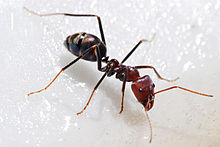
Back ايريدوميرمكس بوربوريوس ARZ Formiga de la carn Catalan Iridomyrmex purpureus CEB Iridomyrmex purpureus Spanish مورچه گوشتخوار Persian Iridomyrmex purpureus French Semut daging ID Daging semut JV Iridomyrmex purpureus Georgian 고기개미 Korean
| Meat ant | |
|---|---|

| |
| Meat ant worker feeding on honey | |
| Scientific classification | |
| Domain: | Eukaryota |
| Kingdom: | Animalia |
| Phylum: | Arthropoda |
| Class: | Insecta |
| Order: | Hymenoptera |
| Family: | Formicidae |
| Subfamily: | Dolichoderinae |
| Genus: | Iridomyrmex |
| Species: | I. purpureus
|
| Binomial name | |
| Iridomyrmex purpureus (Smith, 1858)
| |
| Synonyms[1] | |
| |
The meat ant (Iridomyrmex purpureus), also known as the gravel ant or southern meat ant, is a species of ant endemic to Australia. A member of the genus Iridomyrmex in the subfamily Dolichoderinae, it was described by British entomologist Frederick Smith in 1858. The meat ant is associated with many common names due to its appearance, nest-building behaviour and abundance, of which its specific name, purpureus, refers to its coloured appearance. It is among the best-known species of ant found throughout Australia; it occurs in almost all states and territories except for Tasmania. Its enormous distribution, aggression and ecological importance have made this ant a dominant species.
The meat ant is monomorphic (occurs in a particular form), although there is evidence that certain populations can be polymorphic. It is characterised by its dark-bluish body and red head. It is a medium to large species, measuring 6–12 mm (0.24–0.47 in). The workers and males are approximately the same sizes at 6–7 mm (0.24–0.28 in) and 8 mm (0.31 in), respectively. The queens are the largest and appear mostly black, measuring 12.7 mm (0.50 in). The iridescence in workers ranges from green or blue to plain green and purple, varying in different body parts and castes. Meat ants inhabit open and warm areas in large, oval-shaped mounds that are accompanied by many entrance holes. The nest area is always cleared of vegetation and covered with materials including gravel, pebbles and dead vegetation. They are also polydomous, where a colony may be established in a series of satellite nests connected by well-defined paths and trails. Satellite nests are constructed away from the main nest and nearby areas with valuable food sources so workers can exploit them.
Queens mate with a single male and colonies may have more than one queen until the workers arrive, where they both exhibit antagonism. It takes around one or two months for an individual egg to develop into an adult. Colonies range in size, varying between 11,000 individuals to over 300,000. The meat ant is a diurnal species (active throughout most of the day), especially when it is warm. It forages on trees and collects sweet substances such as honeydew and nectar, and also captures insects or collects the remains of animals. A number of predators eat these ants, including the short-beaked echidna (Tachyglossus aculeatus), numerous species of birds, blind snakes and spiders. This species is also a competitor of the banded sugar ant (Camponotus consobrinus). Meat ants establish territorial borders with neighbouring colonies and solve disputes through ritualised fighting.
Meat ants play an important role in both the environment and for humans. A single nest is capable of dispersing over 300,000 plant seeds; moreover, meat ants have formed symbiotic relationships with many insects. This ant may be used as a form of pest control to kill the cane toad, an invasive species. They can also help farmers to remove animal carcasses by consuming and reducing them to bones in a matter of weeks. Despite this, meat ants are sometimes pests around urban areas and eradicating them is difficult.
- ^ Johnson, Norman F. (19 December 2007). "Iridomyrmex purpureus (Smith)". Hymenoptera Name Server version 1.5. Columbus, Ohio, USA: Ohio State University. Retrieved 1 April 2015.
© MMXXIII Rich X Search. We shall prevail. All rights reserved. Rich X Search